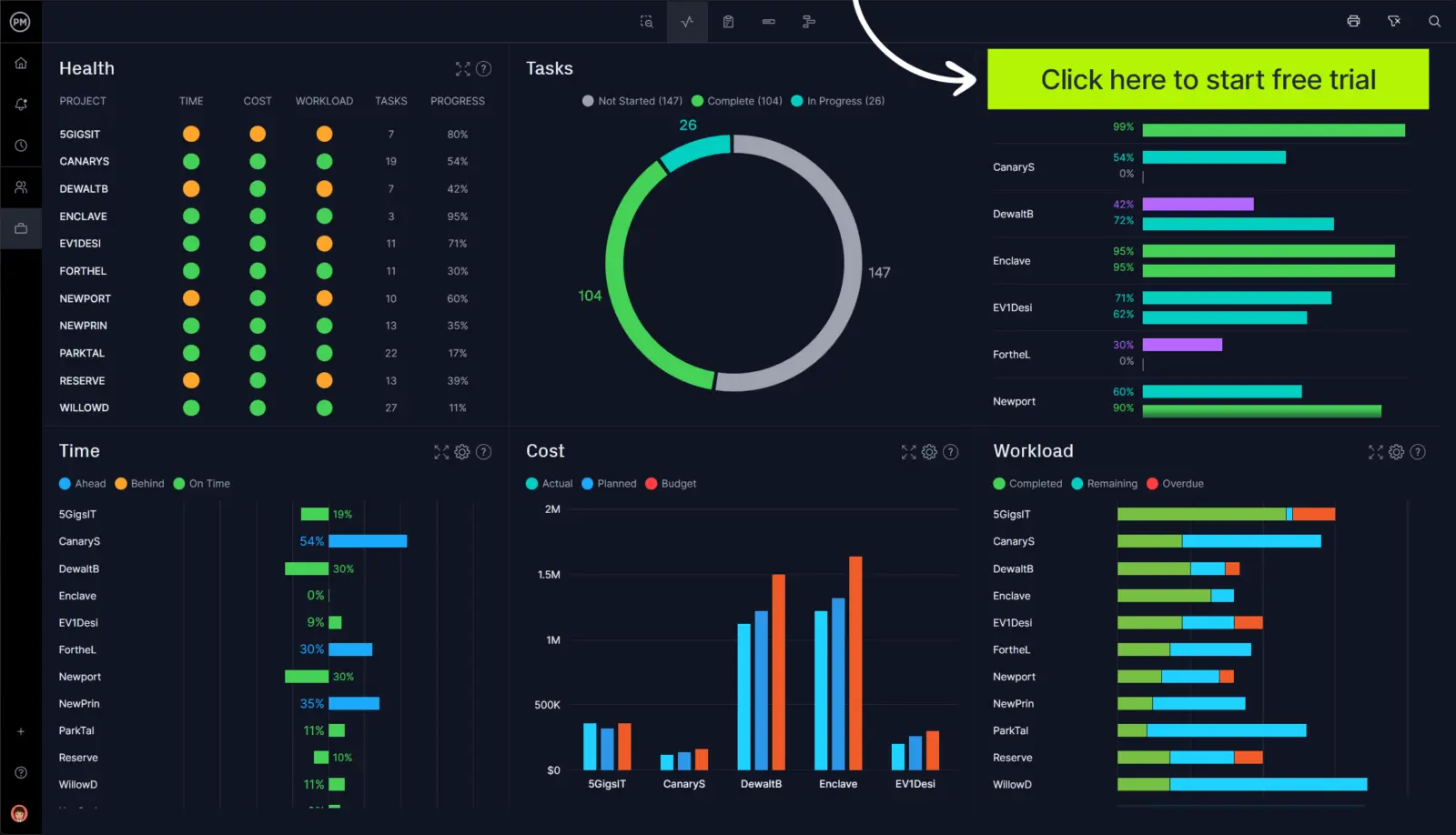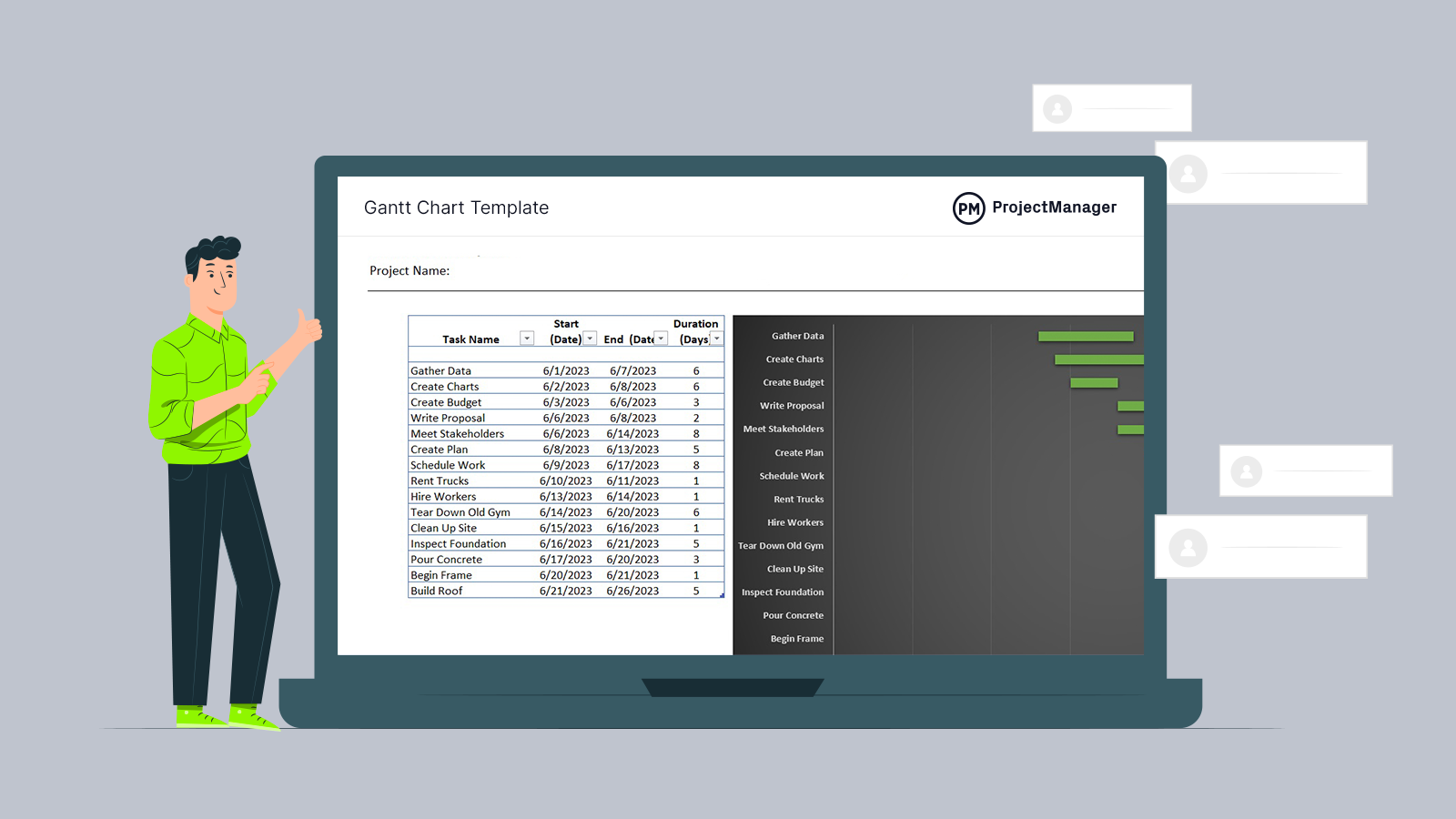Project management is all about solving problems before they happen. That’s why you make a plan, schedule tasks and monitor the work to make sure you’re staying on track. But even the best planning isn’t going to avoid challenges throughout the project. Let’s look at 15 project management challenges and how to deal with them.
15 Project Management Challenges You Should Prepare For
Here are the most common challenges project managers face in their day-to-day lives. Each challenge comes with advice on how to overcome obstacles and take your project management career to the next level.
1. Balancing Project Constraints
There are three constraints that make up the project management triangle: scope, time and cost. If you can balance these three constraints, you’ll deliver a quality project. This requires project management software that can monitor your progress and performance.
ProjectManager is award-winning project management software that has real-time dashboards that give managers a high-level view of their projects with easy-to-read graphs and charts that track project metrics such as time, cost and more. Unlike lightweight project management software, users don’t have to set up our live dashboard. Simply toggle over. It’s ready when you are.

2. Avoiding Scope Creep
Scope creep is when requirements or features increase over a project’s life cycle. This gradual expansion of a project’s scope beyond the original agreement is going to negatively impact the budget and schedule so it’s something to always be aware of and, if there are changes, manage them to avoid as much negative impact as possible.
3. Managing Stakeholder Expectations
Stakeholders have a vested interest in the project and therefore are going to insert themselves into the project. This can be one of the hardest project management challenges to overcome, as stakeholder involvement might slow work down. Managing the stakeholders’ expectations can be done by figuring out who your stakeholders are, what they need to know and when they need to know it. This way you can provide them with that information to keep them from interrupting work and also prepare them for delays or other things that might impact the project.
4. Estimating Costs Accurately to Create a Project Budget
Projects cost money. Accurate estimates of those costs can often impact the profit margin. To create an accurate budget for the project you’ll want to look at your material and labor costs, overhead and any other costs related to the project. It also helps to look at historical data for similar projects and speak to experts to get their opinions on what the costs for the project will realistically be.
5. Assembling the Right Team
The project team is responsible for executing the project. You need to assemble a team that has the skills and experience to do the job at hand. Each member is important as is figuring out the organizational structure of the team. There, the project manager needs to set up rules and procedures, define expectations, establish communication and more.
6. Choosing the Right Project Management Software
You might be able to run a project with our project management software, but it’s not recommended. Project management software will help you execute the project more efficiently and effectively monitor your work to help you stay on track. There are many options, which is why knowing the features you need is important to select the right fit.
7. Identifying Project Risks
Projects are risky endeavors. A risk is an unexpected event that can impact your project, whether good or bad. Project managers try to identify risks prior to starting the project so they can have plans ready to mitigate them. It’s also important to prioritize and track issues in the project to make sure they’re resolved.
8. Estimating the Duration of Projects
A project by definition is something that has a beginning and end that results in a deliverable. Being able to estimate how long the project will take to complete is the first step to creating a project schedule. Each task will have a start date and an end date, which makes up the duration. Estimating the duration of your projects is one of the most critical project management challenges for you as a project manager. But luckily, there are various time estimating techniques you can use such as the critical path method, the program evaluation review technique (PERT), work breakdown structures and more.
9. Scheduling the Work of Your Team
A project schedule is only the start. Now, you have to coordinate your resources with that schedule, including the human resources, which are your team members. They have to be assigned specific tasks that they’re responsible for completing.

Get your free
Gantt Chart Template
Use this free Gantt Chart Template for Excel to manage your projects better.
10. Tracking Project Progress
To make sure that you’re keeping to your schedule, progress needs to be tracked. Project management software can give you a high-level view of your progress with dashboards that track various key performance indicators (KPIs) and reporting can give you more data to better understand if your actual progress is aligned with your planned progress.
11. Dispelling Project Manager Myths
Project managers are often seen to be interfering with the project, rather than helping. It’s difficult to combat the impression of being paper-pushers, admin bullies, people who add unnecessary extra work to a project.
12. Keeping Up With Project Changes
Change is another project management challenge. Changes can come from stakeholders requesting new features to issues with your supply chain. Wherever the change comes from, project managers need to have a plan in place to manage these changes so the impact on the project is minimized. That’s called a change management plan.
13. Staying Relevant to Project Management Trends
This is true for any industry, of course, but because project managers touch so many fields in their daily work, it’s important to be up-to-date not only with relevant project management trends, but also with news, policies, and concerns of consequence to vendors and stakeholders.
14. Losing Project Resources
Project plans will change, and that includes team members. Make sure you have a contingency plan in case your project resources become unavailable.
15. Standing Firm
You are the project advocate, after all, and your team’s advocate, as well. You’ll have to be ready to push back against impacts on project scope with key leaders in your organization and mitigate pushback from your own team. Project management is nothing without great leadership.
Video: Project Manager Challenges
In this video, Jennifer Bridges, PMP, highlights a handful of the biggest challenges project managers face on the job.
If you’re looking for a tool that can help you with your project management challenges, then sign up for our software at ProjectManager.

